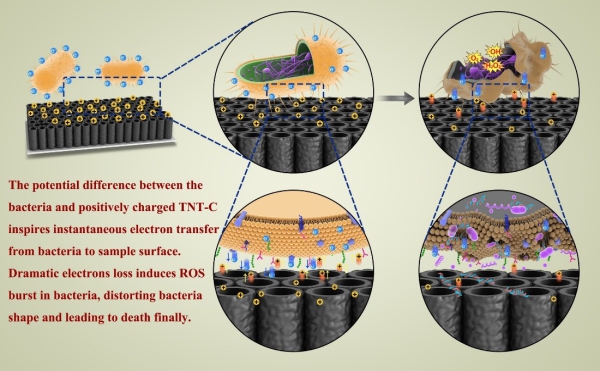A Novel Antibacterial Platform Based on Capacitive Materials
Date:31-05-2018 | 【Print】 【close】
Bacterial infection is one of the most serious complications after surgery leading to not only implant failure but also morbidity and mortality, which inspires scientists to propose series of antibacterial functionalization strategies.
Prof. WANG Huaiyu at the Shenzhen Institutes of Advanced Technology (SIAT) of the Chinese Academy of Sciences, in collaboration with Prof. LI Zhou, from Beijing Institute of Nanoenergy and Nanosystems of the Chinese Academy of Sciences, and Prof. CHU Paul K from City University of Hong Kong, reported a completely new concept that capacitive materials can be endowed with antibacterial properties after electrical charging.
In their study, an external electrical current is applied to capacitive titania nanotubes doped with carbon (TNT-C) to evaluate the effects on bacteria killing and the underlying mechanism is investigated. When TNT-C is charged, post-charging antibacterial effects proportional to the capacitance are observed. The antibacterial efficiency has been confirmed on four strains of bacteria with the anti-biofilm effect achieved by cyclical charging. This capacitance-based antibacterial system works well with both direct and alternating current (DC, AC) and the higher discharging capacity in the positive DC (DC+) group leads to better antibacterial performance.
Extracellular electron transfer observed during early contact contributes to the surface-dependent post-charging antibacterial process. Physiologically, the electrical interaction deforms the bacteria morphology and elevates the intracellular reactive oxygen species level without impairing the growth of osteoblasts. These findings spur the design of light-independent antibacterial materials and provide insights into the use of electricity to modify biomaterials, complementing other bacteria killing measures such as light irradiation.
The paper titled “An Antibacterial Platform Based on Capacitive Carbon-Doped TiO2 Nanotubes after Charging with Direct or Alternating Currents” was published in Nature Communications on May 24, 2018.
This work is supported by National Natural Science Foundation of China (NSFC), “Thousands Talents” Program for Pioneer Researcher and His Innovation Team, the National Key R&D Project from Minister of Science and Technology, Shenzhen Science and Technology Research Funding, Youth Innovation Promotion Association, Leading Talents of Guangdong Province Program and Shenzhen Peacock Program.

Fig. 1 Proposed antibacterial process on DC+ charged TNT-C based on the experimental results